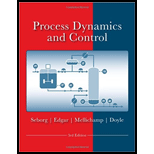
(a)
Interpretation:
For a first order system, it is to be shown that the step response for the change in the input of magnitude M can be approximately modeled by the step response of an integratorfor low values of
Concept introduction:
For chemical processes, dynamic models consisting ordinary differential equations are derived through unsteady-state conservation laws. These laws generally include mass and energy balances
The process models generally include algebraic relationships which commence from
For a first-order system, the transfer function takes the form:
Here,
The transfer function for an integrating process is:
Here,
(b)
Interpretation:
For
Concept introduction:
For chemical processes, dynamic models consisting of ordinary differential equations are derived through unsteady-state conservation laws. These laws generally include mass and energy balances
The process models generally include algebraic relationships which commence from thermodynamics, transport phenomena, chemical kinetics, and physical properties of the processes.
For a first-order system, the transfer function takes the form:
Here,
The transfer function for an integrating process is:
Here,
(c)
Interpretation:
Single step analysis to find
Concept introduction:
For chemical processes, dynamic models consisting of ordinary differential equations are derived through unsteady-state conservation laws. These laws generally include mass and energy balances
The process models generally include algebraic relationships which commence from thermodynamics, transport phenomena, chemical kinetics, and physical properties of the processes.
The transfer function for an integrating process with the time delay of
Here,
Want to see the full answer?
Check out a sample textbook solution
Chapter 5 Solutions
Process Dynamics and Control, 4e
 Introduction to Chemical Engineering Thermodynami...Chemical EngineeringISBN:9781259696527Author:J.M. Smith Termodinamica en ingenieria quimica, Hendrick C Van Ness, Michael Abbott, Mark SwihartPublisher:McGraw-Hill Education
Introduction to Chemical Engineering Thermodynami...Chemical EngineeringISBN:9781259696527Author:J.M. Smith Termodinamica en ingenieria quimica, Hendrick C Van Ness, Michael Abbott, Mark SwihartPublisher:McGraw-Hill Education Elementary Principles of Chemical Processes, Bind...Chemical EngineeringISBN:9781118431221Author:Richard M. Felder, Ronald W. Rousseau, Lisa G. BullardPublisher:WILEY
Elementary Principles of Chemical Processes, Bind...Chemical EngineeringISBN:9781118431221Author:Richard M. Felder, Ronald W. Rousseau, Lisa G. BullardPublisher:WILEY Elements of Chemical Reaction Engineering (5th Ed...Chemical EngineeringISBN:9780133887518Author:H. Scott FoglerPublisher:Prentice Hall
Elements of Chemical Reaction Engineering (5th Ed...Chemical EngineeringISBN:9780133887518Author:H. Scott FoglerPublisher:Prentice Hall
 Industrial Plastics: Theory and ApplicationsChemical EngineeringISBN:9781285061238Author:Lokensgard, ErikPublisher:Delmar Cengage Learning
Industrial Plastics: Theory and ApplicationsChemical EngineeringISBN:9781285061238Author:Lokensgard, ErikPublisher:Delmar Cengage Learning Unit Operations of Chemical EngineeringChemical EngineeringISBN:9780072848236Author:Warren McCabe, Julian C. Smith, Peter HarriottPublisher:McGraw-Hill Companies, The
Unit Operations of Chemical EngineeringChemical EngineeringISBN:9780072848236Author:Warren McCabe, Julian C. Smith, Peter HarriottPublisher:McGraw-Hill Companies, The





